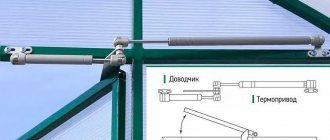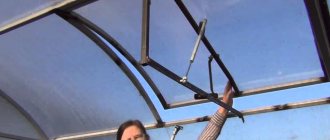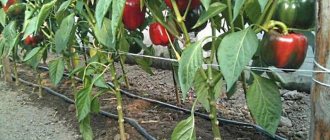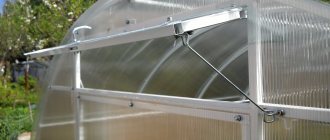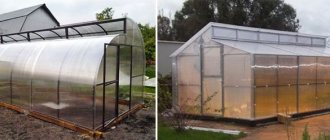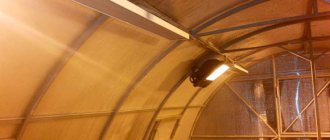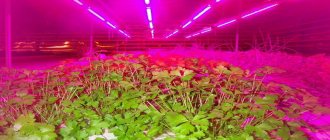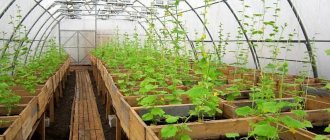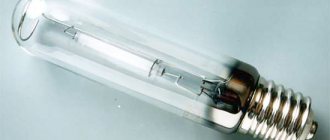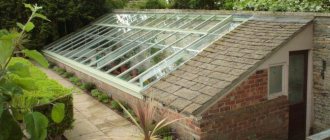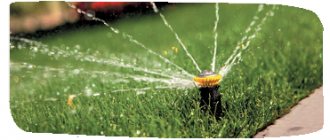Greenhouse owners are well aware that one of the basic rules for growing plants is to organize a flow of fresh air. The task is not easy, because we must take into account that there must be a certain microclimate inside the greenhouse in order to prevent the green spaces from overcooling. It is difficult to control this process manually all the time. And in some situations it is simply impossible. Therefore, an excellent option has been proposed that solves this problem - automatic opening of the greenhouse.
Device for automatically opening windows in a greenhouse Source images.ru.prom.st
Design features
So, what is ventilation of greenhouses, what principles does this process follow? Essentially, these are several vents installed in the greenhouse structure, which automatically open and close.
And here the question arises about the number of vents to be installed. That is, how many of them are needed so as not to change the microclimate. To do this, you will have to calculate the internal volume of the greenhouse, and based on this parameter, select the number of openings. It is not recommended to do this on your own; you can make a mistake that will negatively affect the future condition of the plants. Leave it to the experts.
Next, you need to decide where the windows will be located. There are two options here:
- End location. To do this, doors and vents are installed on the end walls of the greenhouse. By opening them, you can quickly reduce the humidity inside the room. This is a good ventilation option, which also has a significant disadvantage - the formation of drafts. And this often leads to diseases of green spaces.
End arrangement of vents Source freeimport.ru
- Lateral location. Better than the end one in terms of proper air circulation. Namely: from bottom to top. Therefore, it is recommended to place the windows as high as possible. At the same time, cold air, sinking to the ground, has time to heat up. That is, it does not have a negative effect on plants.
Lateral arrangement of vents Source static.wixstatic.com
See also: Catalog of popular garden house projects
Dimensions
To properly organize ventilation in a greenhouse, it is necessary to correctly calculate the size and number of vents. The area of the openings with flaps should be 20-30% of the floor area in the greenhouse. Experts advise placing one ventilator every two meters.
Greenhouses measuring 3x6 meters are quite popular among vegetable growers. The opportunity to install a 6-meter-long structure is available on almost every site. When creating ventilation in a greenhouse of this size, you need to install 3-4 vents measuring 400x1200 mm.
Classification of automatic vents
Automatic ventilation of a greenhouse is the process of opening and closing the windows without human intervention. That is, you can safely leave, leaving the greenhouse unattended, and be sure that the microclimate in it will be in the required condition.
What kind of windows do companies offer today? In principle, this is a standard type of design. They differ from each other only in the drive that opens and closes them. There are two options here:
- Hydraulic. The design uses a conventional hydraulic cylinder into which a liquid is pumped that responds to changes in outside temperature. That is, when the temperature inside the greenhouse has risen greatly, the liquid inside the cylinder expands and puts pressure on the pusher. He, in turn, pushes the window. And, conversely, when the temperature drops, the liquid contracts and pulls the pusher towards itself. It should be noted right away that such automatic opening of a window in a greenhouse is non-volatile, that is, not connected to the power supply.
Automatic opening mechanism with hydraulic cylinder Source newplastic.rf
See also: Catalog of companies that specialize in the sale and installation of greenhouses
- Electric , in the design of which a thermal drive is installed. From the name it becomes clear that the window opening drive is powered by an electric current network. And this, on the one hand, is a minus, because power outages outside the city are not uncommon. These devices also include sensors that monitor the temperature and humidity inside the greenhouse. It is from them that the signal to open or close the openings comes. Some models are additionally equipped with fans with heating elements and hydraulic nozzles.
Automatic opening mechanism of electric type Source images.ru.prom.st
Which model to give your preference is difficult to answer. Each summer resident solves his own problems on his own. But it should be noted that the hydraulic option is much cheaper. And it refers to non-volatile units. The only negative is the slow opening and closing of the windows. It's all about the fluid inside the hydraulic cylinder. Because it takes time to cool or heat up. At the same time, the hydraulic mechanism for opening a window in a greenhouse has limited possibilities to open the opening slightly - 45 cm, no more. And the minimum temperature at which it closes the transoms is 15 °C.
In all these respects, electric ones are superior to hydraulic ones. They quickly open and close, which makes it possible to maintain the microclimate inside the greenhouse with high precision. And temperature and humidity sensors strictly monitor all required air parameters. But these models are very expensive, and some summer residents cannot afford them. Therefore, the latter choose hydraulic models. At the same time, the device for opening a window in a hydraulic-type greenhouse is simpler. Essentially, it is a small diameter cylinder to which a lever is hingedly attached. The latter is attached to the window frame with its free end.
Fastening to the greenhouse frame with bolts Source st47.stblizko.ru
Bimetallic
Bimetallic ventilators consist of two metal plates with different expansion rates when heated. The hot air in the greenhouse heats the plates and one of them bends into an arc, opening the window leaf. When the air cools, the metal returns to its original state and the device closes.
Making bimetallic automation yourself is quite simple. The materials needed for manufacturing can always be found at your summer cottage. You will need two metal plates: vinyl plastic and roofing iron. They stick together. One end is fixed, and the other is connected by a rod to the window leaf. The result is a good automatic system. The only disadvantage of this drive is its low power level, so it is only suitable for lightweight structures.
How to ventilate a greenhouse correctly
In fact, the process of ventilating greenhouses is limited only by the required temperature and humidity inside the structure. After all, the main task is to create optimal conditions for plant growth. Therefore, we suggest that you familiarize yourself with the basic rules:
- You cannot create conditions under which drafts will occur inside the greenhouse.
- For uniform ventilation, openings with opening frames must be installed evenly along the entire length of the building.
- It is better to ventilate the greenhouse in the evening and in the morning, when the temperature outside is more favorable for plants.
- Plant inside the greenhouse only those plants for which the humidity and temperature conditions of growth will be approximately the same.
- Purchase ventilation mechanisms strictly according to the load they can withstand. The manufacturer must indicate this in the product passport. To do this, you will additionally have to determine the weight of the window.
Electrical
The electric type of ventilation is equipped with temperature relays and fans. When the air overheats, the relay is activated and turns on the hood. This system is powerful, compact, and quickly responds to temperature differences. A significant disadvantage is the dependence on electricity. If this type of ventilation is used in the greenhouse, the purchase of backup power supplies will be required.
The use of alternative energy sources (solar panels, wind power) will help protect plants from overheating in the event of a power outage. Due to the need to purchase additional elements, these systems are expensive. But it is possible to choose the power of the electric motor. For heavier structures, you will have to spend money on a strong drive, while for lighter ones, low-power ones are suitable.
Selection of frame material
The durability and reliability of the entire structure depends on the characteristics of the frame. It is thanks to the frame that the greenhouse can withstand the effects of a negative external environment: the weight of snow masses, the force of rain, gusts of wind, and mechanical damage.
Don't skimp on frame material! It is better to invest financially once and build a reliable structure than to replace and repair the greenhouse every year.
Tree
Advantages:
The material is environmentally friendly, not susceptible to corrosion, has good thermal insulation and is low in cost
Flaws:
The tree is fragile, absorbs water well, this leads to rotting of the wood, requires additional care measures - treatment with protective compounds against insects, humidity, mold, keep in mind that a wooden greenhouse will have to be constantly updated and repaired.
For a greenhouse on a wooden base, it is necessary to additionally equip a water outflow system, otherwise such a structure will not last very long. Wooden greenhouses are popular only because of the availability of the material, its ease of processing and low cost. But to get a truly reliable design, consider other options for frame materials.
Plastic
PVC is an ideal material for a garden greenhouse, but ready-made plastic greenhouses are rarely found on sale. Plastic is quite difficult to process, which results in the high cost of the product.
The plastic frame has practically no disadvantages, but is endowed with many advantages:
- aesthetic in appearance;
- is characterized by high strength;
- is resistant to various chemicals, acids and alkalis;
- not subject to rotting and rust;
- Light in weight, which ensures ease of installation.
Aluminum
Such structures are assembled from profiles or pipes.
Aluminum frames have both pros and cons that you need to know and take into account:
Advantages:
Lightweight and easy to install, resistant to corrosion, requiring minimal care and maintenance.
Flaws:
They are too expensive and have poor thermal insulation, which requires the use of additional covering materials when constructing a greenhouse.
Steel
For modern gardeners, a steel greenhouse frame is becoming one of the best choices in terms of price and quality. This frame is durable and can withstand increased loads. The material also has a low price.
For all its advantages, the aluminum frame for a greenhouse is susceptible to rust and has a low level of thermal insulation.
Steel greenhouse frames are usually offered in two versions:
Expert opinion Kulikov Vladimir Sergeevich
Remember that steel is susceptible to rust, so when using this material it is galvanized or coated with a protective layer of paint.
Galvanized frames will be a little more expensive in cost, but they are preferable to use because of their durability. Using a galvanized frame, the summer resident will not need to additionally repair and protect the frame material for 10-12 years.
If you choose a steel frame made of pipes or profiles to make the structure more durable, pay attention to some nuances:
It is necessary that as few elements as possible are used in the greenhouse structure. Ideally, use welded front arcs or solid bent ones for the frame. Profile section
If the components of the greenhouses are made of profiles, try to take material with high performance - a maximum of 20x40 mm. Pay attention to the thickness of the metal layer - it should be from 1.2 mm. But provide a distance between the bent arches of 0.67 m. Otherwise, the first layer of snow will cause the frame to bend.
The need for a ventilation system in a greenhouse
In summer, when solar activity is high, a closed greenhouse becomes not a blessing, but an evil even for the most heat-loving plants. The air temperature in it can rise to +50C. No culture can withstand such extreme values without damage. The differences between day and night temperatures sometimes reach 30C, which also does not contribute to the full development of plants.
Greenhouse ventilation systems perform the following functions:
- eliminate the risk of daytime temperatures rising above critical levels;
- eliminate sudden changes between day and night temperatures;
- eliminate air stagnation, ensuring normal air circulation;
- eliminate the risk of condensation.
In damp, poorly ventilated greenhouses, spores of pathogenic microorganisms multiply at high speed. Many pests also prefer greenhouse conditions - aphids, woodlice, slugs, spider mites. Thus, creating a ventilation system is a necessary condition for obtaining a harvest.
All greenhouse crops need ventilation
Greenhouses made of polycarbonate
The advantages of polycarbonate plastic make it possible to construct greenhouse structures from it, characterized by a high rate of heat conservation and energy savings. Characteristics of a polycarbonate greenhouse:
- The lightness of the material allows you to quickly build a greenhouse. You can even do this yourself, with your own hands. In this case, there is no need to make a reinforced frame. It is enough to design it correctly so that the greenhouse building can withstand a large layer of snow and ice.
- Polycarbonate is stronger than polyethylene film and fragile glass, which require periodic replacement.
- Transparency allows you to supply plants with the necessary amount of light for normal growth and vegetation.
- At the same time, the material is equipped with a protective film from ultraviolet and infrared radiation, protecting greenhouse plants.
- The cellular structure allows you to effectively retain heat inside the structure. The thickness of the coating can be from 4 to 32 mm. The larger this value, the more energy efficient the structure, the lower the cost of heating the air.
- The joints of polycarbonate sheets are connected with special fasteners, the ends are closed with ends. Dust, small insects, moisture, etc. do not get inside the honeycomb; the material always remains clean and translucent.
- Thanks to a wide range of operating temperatures, plastic can withstand high thermal loads without changing its qualities or properties.
